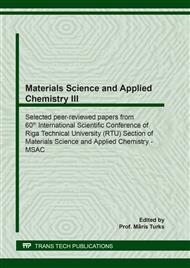p.28
p.35
p.41
p.48
p.54
p.63
p.70
p.76
p.81
Prediction of Solid Solution Formation among Chemically Similar Molecules Using Calculation of Lattice and Intermolecular Interaction Energy
Abstract:
Several 2-substituted 4-nitrobenzoic acid (NBA) derivatives such as 2-chloro-4-nitrobenzoic acid (2C4NBA), 2-methyl-4-nitrobenzoic acid (2CH34NBA) and 2-hydroxy-4-nitrobenzoic acid (2OH4NBA) were selected as model compounds because of their availability and chemically similar structures, in which the different group/atom (R) does not significantly affect the dominant intermolecular interactions – hydrogen bonds formed by the carboxylic group [1]. Quantum chemical calculations of lattice and intermolecular interaction energy were carried out to identify possible factors, which could be, used in prediction of the formation of solid solutions (SS) in binary systems of chemically similar molecules, in this case - various nitrobenzoic acid derivatives. Meanwhile, crystallization experiments were used to determine the experimental information about formation of solid solutions. The obtained crystalline phases were characterized by combined use of powder X-ray diffraction (XRPD) and differential scanning calorimetry/thermogravimetry (DSC/TG) [2].
Info:
Periodical:
Pages:
54-59
Citation:
Online since:
June 2020
Authors:
Price:
Сopyright:
© 2020 Trans Tech Publications Ltd. All Rights Reserved
Share:
Citation:


